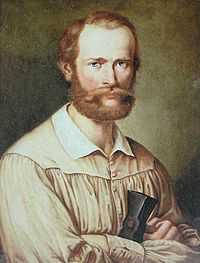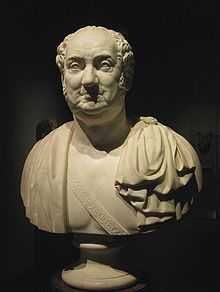Ernst von Bandel

(1793-1864)
Joseph Ernst von Bandel (17 May 1800, Ansbach - 25 September 1876, Neudegg, near Donauwörth) was a German architect, sculptor and painter.
Life
His father was the President of the Appellate Court in Ansbach.[1] His childhood was dominated by political events (the French occupation in 1805; the 1813 War of Liberation) which left him a lifelong patriot. When he was fourteen, he began drawing lessons at the Academy of Fine Arts, Nuremberg, with the engraver Albert Christoph Reindel. Two years later, he went to Munich to apply for a position in the Royal Bavarian Forestry Office. While there, he met the architect Karl von Fischer and became his student.[1]
His father's death in 1818 and the resulting financial stress almost forced him to give up his interest in art, but he was able to arrange a generous grant from King Maximilian I. The following year, he was given a job as a draftsman at the Hofbauamt (an office responsible for the construction and maintenance of the Royal buildings).

Career growth
In 1820, he refused a job offer as an assistant to the architect Leo von Klenze, as he was not amenable to Bandel's preference for the Gothic style. Later that year, he entered the Academy of Fine Arts, Munich, where he studied under Moritz Kellerhoven, Wilhelm von Kobell and others.
With a final stipendium from the King, he was able to study in Italy from 1825 to 1827.[2] While in Rome he met Bertel Thorvaldsen and several members of the Nazarene movement, but was unimpressed by them. His closest associates were Ludwig Schwanthaler and Heinrich Max Imhof. Shortly after his return to Germany, he got married and found employment with Christian Daniel Rauch at the Glyptothek, where he remained until 1834. In 1832, he and Hans Ferdinand Massmann founded the local Gymnastics Society.
He found himself receiving little support or understanding from Maximilian's successor, Ludwig I, so he moved to Berlin in 1834, following his former employer, Rauch, who was working on a huge equestrian statue of Frederick the Great. He soon began making his own proposals for a grand National Monument,[2] but got little encouragement and less interest, so he moved again, this time to Hanover where, with the intercession of architect Ernst Ebeling, King William IV entrusted him with the design of the residential palace. he also worked on the new auditorium at Georg August University in Göttingen, creating the pediment reliefs.[1]
The Hermannsdenkmal

From 1837 to 1846 he lived in Detmold, working on the Hermannsdenkmal, which commemorates a victory over the Roman Army by the Cheruscian Prince, Arminius (Hermann, in German).[2] After a great deal of initial support for the project, public interest began to wane and donations decreased dramatically. Bandel had to use up his entire personal fortune in an effort to complete the monument.[1] In 1846, he had a falling out with the Hermannsverein (the civic group promoting the project). He returned to Hanover, broke and embittered, but began soliciting donations again. After the end of the Franco-Prussian War, the government and the public found their enthusiasm for the project restored.[1] It was finally inaugurated on 16 August 1875 by Kaiser Wilhelm I, who had provided the necessary sum for completion.
Bandel took part in the ceremony, although he was badly weakened by kidney disease. The Kaiser provided the funds for him to recuperate in Italy, but he died on the return trip at his half-brother's estate near Donauwörth.
References
- ↑ 1.0 1.1 1.2 1.3 1.4 Hyacinth Holland (1902), "Bandel, Ernst von", Allgemeine Deutsche Biographie (ADB) (in German) 46, Leipzig: Duncker & Humblot, pp. 202–203
- ↑ 2.0 2.1 2.2 Margarete Braun-Ronsdorf (1953), "Bandel, Ernst Joseph von", Neue Deutsche Biographie (NDB) (in German) 1, Berlin: Duncker & Humblot, pp. 574–574, (full text online)
Further reading
- Brigitte Bötel: Joseph Ernst von Bandel (1800–1876). Das bildhauerische Werk. Dissertation. University of Göttingen 1984
- Rose Hellfaier: Ernst von Bandel an Wilhelm Tegeler. Briefe zur Entstehungsgeschichte des Hermannsdenkmals 1850-1864. Lippische Landesbibliothek (LLB), Detmold 1975
- Burkhard Meier: Das Hermannsdenkmal und Ernst von Bandel. Zum zweihundertsten Geburtstag des Erbauers. Topp+Möller, Detmold 2000, ISBN 3-9806101-7-9.
- Hermann Schmidt: Ernst von Bandel. Ein deutscher Mann und Künstler. Meyer, Hanover 1892. (Digitalized @ LLB)
- Hermann Schmidt: Ernst von Bandel und das Hermanns-Denkmal. Hanover 1893. (Digitalized @ LLB)
- Anonymous: Ernst von Bandel, 1800-1876, Bildhauer in Hannover. Beiheft zur Ausstellung Ernst von Bandel, das Hermannsdenkmal und andere Arbeiten. Historisches Museum am Hohen Ufer, Hanover 1976.
External links
| Wikimedia Commons has media related to Ernst von Bandel. |
- Hermannsdenkmal @ German Wikisource
- Literature by and about Ernst von Bandel in the German National Library catalogue
|